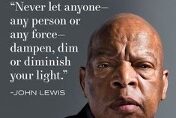A video and a year of attention made possible what previously seemed impossible – holding police officers accountable for deaths of Black people caught in a racially biased society and criminal justice system. On May 25, 2020, George Floyd was murdered. On April 21, 2021, a Minnesota jury found Derek Chauvin, a local police officer, guilty of three counts of murder. As important as this verdict is, there is a long, long road ahead to resolving the underlying structural racism and injustices of the criminal justice system in the United States.
This week we turn to a leader who faced racism his entire life. He faced it with faith, with a commitment to nonviolence, and a decision to devote his life to “making good trouble.” Critical Conversations’ reader Sally St John responded to my January post, The Long View: Showing Up Consistently for Justice for All, by offering lessons she gleaned from reading Jon Meacham’s His Truth is Marching On-John Lewis and the Power of Hope, a biography of civil rights leader John Lewis.
Indeed, John Lewis models what it means to live a life consistently showing up for “justice for all.” He devoted his life to that ideal. His biography is instructive as we explore what we can do each day to advance an end to racism and its deadly impact. Thank you, Sally, for your reflection and offering to tell our readers about John Lewis and what he continues to teach us.
In his book, Truth is Marching On, author Jon Meacham reviews John Lewis’ entire life while focusing in-depth on the important formative years of 1957-1970 when a very young Lewis was at the center of the American Civil Rights Movement.
Having lived through 2020, one can’t help but believe that history doesn’t repeat, it rhymes. Meacham does a historical scholar’s job of presenting the facts, context and significance of Lewis’ life. The biography fleshes out issues that became much more apparent to all when Black Lives Matter became a dominant social movement in spring-summer 2020.
The author quotes Lewis’ description of his early years in Troy, Alabama. “I was fundamentally disturbed by the unbridled meanness of the world around me.” Amazingly, he overcame the pervasive oppression of Jim Crow without succumbing to bitterness and hatred.
An uncle’s generosity allowed him to travel to Nashville’s American Baptist Theological with $100 in his pocket in 1957. He also had the determination to work on campus to pay his living expenses at the tuition-free institution.
Although Social Gospel devotion existed earlier, it was Rev. Kelly Miller Smith’s First Baptist Church in Nashville that introduced Lewis to the “movement“ in 1958. Meacham sketches the arc of events and people that reinforced the nonviolent basis of Lewis’ life. James Lawson was a mentor who studied Gandhi’s tactics in India. Lawson weaved those threads with Martin Luther King Jr.’s leadership from Montgomery, and the seminal book by Howard Thurman, Jesus and the Disinherited.
Diane Nash and Ella Baker, two less well-known and important African-American civil rights leaders, proved to be influential, also. These strong women refused to believe that they were lesser human beings. Through active involvement with the NAACP, the Student Nonviolent Coordinating Committee and the Southern Leadership Conference, they led efforts to accelerate the course of the civil rights movement.
In 1958, Lewis attended nonviolence workshops at the Highlander Folk School in Tennessee. Its alumni included Pete Seeger, Rosa Parks, Martin Luther King Jr. and Ralph Abernathy. Septima Clark directed those tactical trainings; they reinforced the stalwart pursuit of freedom through marches and demonstrations.
These were courageous people whose actions included activities where they and others were spit upon, beaten and jailed:
- Organizing protests that integrated lunch counters across the South in 1960
- Bringing together Freedom Riders that rode buses to integrate transportation in 1961
- Being front and center on Bloody Sunday at the Pettus Bridge in Selma, Alabama, that promoted Voting Rights in1965
All of these actions used nonviolent means, wherein they were subject to both bodily harm and arrest. These heroes learned to “curl our bodies so that our internal organs would escape direct blows,” Lewis recalled.
Meacham reminds the reader of those who didn’t survive these struggles: Medgar Evers (1962), 3 Summer Freedom workers in MS (1964), ultimately Martin Luther King Jr.(1968). These deaths, along with the four girls in a Birmingham church bombing (1963) and the Kennedy brothers’ assassinations, (John 1963) and Robert (1968), all weighed heavily on Lewis and those who persevered with him. From this side of history, it may be easy to forget the sacrifice and personal toll taken on those who sought a beloved community and greater good.
Meacham offers readers an opportunity to understand the courage and cost of nonviolence and to continue to “make good trouble” today.




Non-violence was the method used by Christ, Gandhi and Martin L King Jr. Violence was used by FDR and Harry Truman against the Germans, Italians and Japanese. Lincoln used violence to defeat the Confederacy. The moral arguments for and against use of violence are complex.
Agreed, thanks Phil. I actually started out writing something that pointed to both side and it got too complex. Decided to focus on John Lewis and his legacy. Peace, Tom
Good job Tom!!! Whets my appetite to read the biography. Thank you
Thanks Evangelyn, I think you will enjoy it! Tom